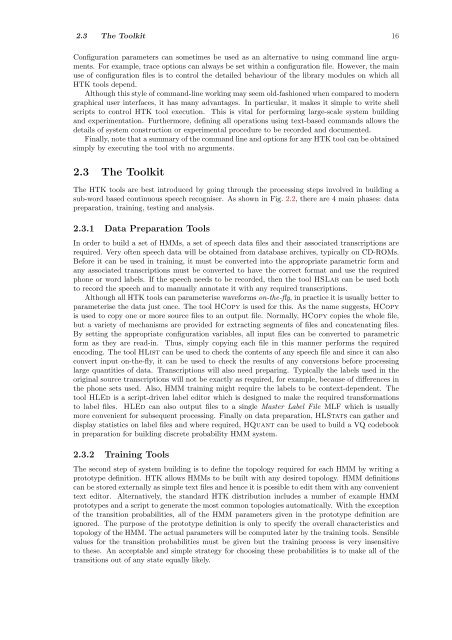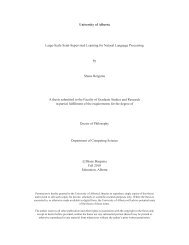The HTK Book Steve Young Gunnar Evermann Dan Kershaw ...
The HTK Book Steve Young Gunnar Evermann Dan Kershaw ...
The HTK Book Steve Young Gunnar Evermann Dan Kershaw ...
- No tags were found...
You also want an ePaper? Increase the reach of your titles
YUMPU automatically turns print PDFs into web optimized ePapers that Google loves.
2.3 <strong>The</strong> Toolkit 16Configuration parameters can sometimes be used as an alternative to using command line arguments.For example, trace options can always be set within a configuration file. However, the mainuse of configuration files is to control the detailed behaviour of the library modules on which all<strong>HTK</strong> tools depend.Although this style of command-line working may seem old-fashioned when compared to moderngraphical user interfaces, it has many advantages. In particular, it makes it simple to write shellscripts to control <strong>HTK</strong> tool execution. This is vital for performing large-scale system buildingand experimentation. Furthermore, defining all operations using text-based commands allows thedetails of system construction or experimental procedure to be recorded and documented.Finally, note that a summary of the command line and options for any <strong>HTK</strong> tool can be obtainedsimply by executing the tool with no arguments.2.3 <strong>The</strong> Toolkit<strong>The</strong> <strong>HTK</strong> tools are best introduced by going through the processing steps involved in building asub-word based continuous speech recogniser. As shown in Fig. 2.2, there are 4 main phases: datapreparation, training, testing and analysis.2.3.1 Data Preparation ToolsIn order to build a set of HMMs, a set of speech data files and their associated transcriptions arerequired. Very often speech data will be obtained from database archives, typically on CD-ROMs.Before it can be used in training, it must be converted into the appropriate parametric form andany associated transcriptions must be converted to have the correct format and use the requiredphone or word labels. If the speech needs to be recorded, then the tool HSLab can be used bothto record the speech and to manually annotate it with any required transcriptions.Although all <strong>HTK</strong> tools can parameterise waveforms on-the-fly, in practice it is usually better toparameterise the data just once. <strong>The</strong> tool HCopy is used for this. As the name suggests, HCopyis used to copy one or more source files to an output file. Normally, HCopy copies the whole file,but a variety of mechanisms are provided for extracting segments of files and concatenating files.By setting the appropriate configuration variables, all input files can be converted to parametricform as they are read-in. Thus, simply copying each file in this manner performs the requiredencoding. <strong>The</strong> tool HList can be used to check the contents of any speech file and since it can alsoconvert input on-the-fly, it can be used to check the results of any conversions before processinglarge quantities of data. Transcriptions will also need preparing. Typically the labels used in theoriginal source transcriptions will not be exactly as required, for example, because of differences inthe phone sets used. Also, HMM training might require the labels to be context-dependent. <strong>The</strong>tool HLEd is a script-driven label editor which is designed to make the required transformationsto label files. HLEd can also output files to a single Master Label File MLF which is usuallymore convenient for subsequent processing. Finally on data preparation, HLStats can gather anddisplay statistics on label files and where required, HQuant can be used to build a VQ codebookin preparation for building discrete probability HMM system.2.3.2 Training Tools<strong>The</strong> second step of system building is to define the topology required for each HMM by writing aprototype definition. <strong>HTK</strong> allows HMMs to be built with any desired topology. HMM definitionscan be stored externally as simple text files and hence it is possible to edit them with any convenienttext editor. Alternatively, the standard <strong>HTK</strong> distribution includes a number of example HMMprototypes and a script to generate the most common topologies automatically. With the exceptionof the transition probabilities, all of the HMM parameters given in the prototype definition areignored. <strong>The</strong> purpose of the prototype definition is only to specify the overall characteristics andtopology of the HMM. <strong>The</strong> actual parameters will be computed later by the training tools. Sensiblevalues for the transition probabilities must be given but the training process is very insensitiveto these. An acceptable and simple strategy for choosing these probabilities is to make all of thetransitions out of any state equally likely.
















